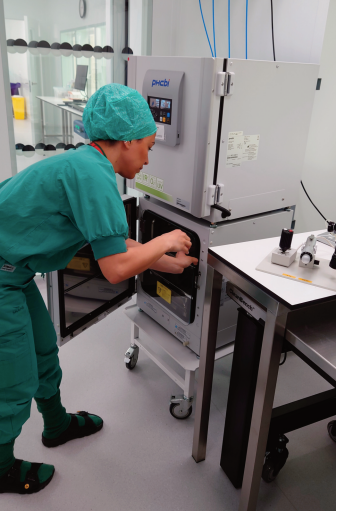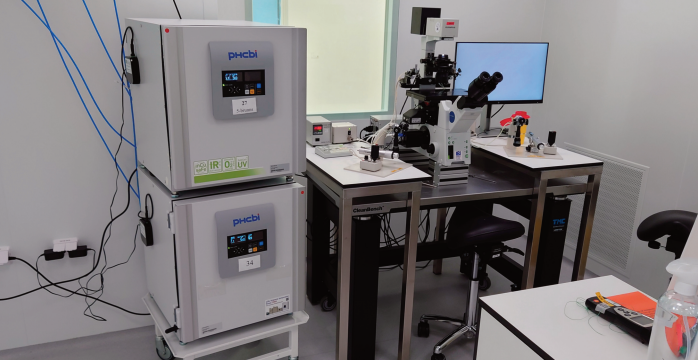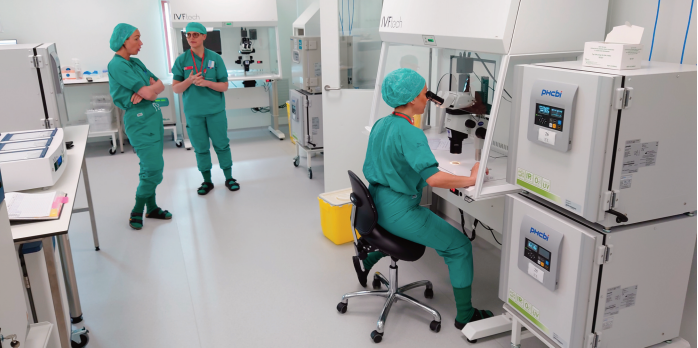Sweden’s Reproduction Medicine Center (RMC) in Malmo is one of Sweden’s largest public reproductive healthcare facilities. In recent years, a major expansion of the clinic’s services has created an essential need to expand the premises and introduce new state-of-the-art equipment.
Following many years of careful development and planning, the new center was opened in October 2021, giving the ‘smallest patients’ – the embryos at the core of its IVF work – the perfect environment in which to thrive. This required meticulous preparations of precise requirements.
The RMC first opened its doors in 2007 with a small premise in the hospital area of Malmö with just 15 staff members. Over time, the scope of IVF has expanded, in addition to the introduction of new Swedish regulations that allow single women, homosexual, and transsexual couples, as well as heterosexual couples, to seek IVF treatment.
Over 45 staff at the RMC clinic – including doctors, embryologists, nurses, midwives, and secretaries – are now meeting with around 28,000 patients annually. The IVF laboratory handles 1200 fresh IVF treatments and 600 frozen cycles yearly.
The center can also provide additional treatments, including hormonal substitutions and ‘fertility preservation’ of gametes, for instance, for cancer patients enduring chemotherapy that could damage their gametes or for transexual people starting a hormonal treatment. Additionally, the RMC has an onsite donor bank offering donation services.
Image Credit: PHC Europe B.V.
Out of IVF (in vitro fertilization) treatments, the RMC clinic is second in size to Gothenburg’s Sahlgrenska IVF clinic.
“Our remit covers a lot of other treatments beyond IVF, and we have close reproductive research collaborations with Skåne University, but also other fertility clinics in Sweden and Denmark,” explains Dr. Ingela Liljeqvist Soltic, Unit Manager of the Centre’s Laboratory.
“We needed a bigger area and new facilities to match our expansion. After seven years of searching for a proper building able to support an IVF laboratory’s needs, as the supply of gases and liquid nitrogen, plus easy to reach for our patients, the clinic was able to move in the Autumn of 2021 to a newly built facility that is three times bigger than our previous premises.”
Precisely controlled environment for sensitive embryos
The relocation and expansion of an IVF clinic, like the Reproductive Medicine Center, demands years of careful planning due to the sensitive nature of the biological samples that it works with.
“At the core of our work is providing the right environment for embryos and gametes,” Dr. Soltic explained.
“Oocytes and embryos particularly are very sensitive to all fluctuations in the environment. So, it is vital to keep their environment in terms of temperature, pH, and gases stable. That was one of the main focuses when we were planning to build the clinic and the clean room. When you build an IVF lab, I believe everything must be built around the oocytes and embryos. Our focus is, of course, for adult patients, but also, we have our ‘small patients’ in the lab – the embryos.”
“Controlled conditions are essential in IVF because the culture environment can have an impact on the new individual,” she continued.
“The environment must be controlled and maintained at optimal every minute of every day, not only for the very start but because inconsistencies in the environment could affect the individual much later on – even several years later, I talk about epigenetics, which means that external influences e.g. the environment of the embryos, will affect the genetics.”

Image Credit: PHC Europe B.V.
It’s important to get used to new equipment and fully understand how it works. We have very good results with the PHCbi Incubators.”
Dr. Ingela Liljeqvist Soltic, Unit Manager, Centre’s Laboratory
As soon as an oocyte is collected from a patient, it must be securely placed in an optimal environment and at the appropriate temperature. This must be sustained across the entire process of fertilization and development in the IVF lab, up to the moment of transfer back to the uterus or vitrification.
“The whole clean room and workflow are built around the oocyte and the logistics around how we handle them,” said Dr. Soltic. “When you make the laboratory larger, you have to think about in terms of managing the oocyte, for example, minimizing its transport within the lab. It’s all about the environment.”
Intricate development process
RMC was quick to realize that expansion into a larger space would be necessary. Still, the particular challenges that come with the relocation of an entire IVF clinic brought about the meticulous operation of finding and designing a new facility that would meet the requirements.
“As we are a part of the Skånes University Hospital in Malmo, we wanted to be located close to the University Hospital, and close to the patients via train and bus stations, easy for them to get to the clinic,” said Dr. Soltic.
“On top of this, we still had to address technical challenges, such as our need to obtain and transport liquid nitrogen frequently – every week and sometimes, twice a week. We also need delivery of large quantities of gas as carbon dioxide and nitrogen to supply all incubators. The new clinic is built for the possibility to expand the lab area and the amount of instruments, e.g. incubators. Incubators, supporting each workstation, while processing gametes and embryos, but also for embryo culture up to 6 days.”
Drawing up the appropriate plans for the empty property’s interior alone necessitated an additional two years.
I read that PHCbi were using another conductor for the gas in their Incubators, which made them faster in getting back to the environment that I required. That was exactly what I was looking for as a functional working incubator.”
Dr. Ingela Liljeqvist Soltic, Unit Manager, Centre’s Laboratory
“We had to decide how to make the new site convenient and attractive to the patients, of course, but also for laboratory personal working in the cleanroom to achieve the best environment and situation for the oocytes and embryos,” said Dr. Soltic.
New incubation capacities
A crucial part of the planning was ensuring that the center was fitted with suitable technology. Incubators act as artificial uteri and are considered vital pieces of equipment. Oocytes and embryos demand precise control over temperatures and conditions for survival and culture.
The RMC clinic has acquired 11 of PHCbi’s latest, most compact (50 L) Multigas Incubator, the MCO-50M-PE. RMC also possesses incubators from previous PHC companies, Sanyo and Panasonic. These were provided by PHC Europe’s Swedish specialist IVF distributor, Vitrotech.
“When I started at the clinic, we had 50 litere Sanyo and Panasonic incubators,” said Dr. Soltic. “I believe they are robust incubators in terms of stability, but Vitrotech explained about some new PHCbi Multigas incubators.”

Image Credit: PHC Europe B.V.
Each day, the Embryologist faces the challenge of ensuring the environment of the culture conditions remains as stable as possible. One of the main priorities when conceiving plans for the new lab was finding a way to contain environmental fluctuations. The idea was to install more work incubators to reduce any impact from door openings significantly.
“I read that PHCbi were using another conductor for the gas in their Incubators, which made them faster in getting back to the environment that I required. This convinced me to get them to the new IVF lab as working incubators.” Dr. Soltic said.
The compact 50 L PHCbi Multigas Incubators were easy to join to the external alarm system that RMC use, which facilitates monitoring carbon dioxide gas concentration and temperature.
“All instruments and devices in the IVF lab, taking care of the gametes and embryos, need to be monitored by an external measure and alarm system. A smaller incubator chamber helps to maintain a stable environment and get a fast return to the desired environment after opening, but when you have an incubator with a smaller chamber, it’s not as easy to incorporate a system that constantly monitor the gas and the temperature,” She added.
Service and support
Vitrotech organized installation, ensuring that the equipment was safely connected to the gas supply.
“Everything was new in the facility. Even the gas supply needed to be established,” said Dr. Soltic. “Vitrotech have ensured that the PHCbi was in place.”
Since October 2021, Dr. Soltic and her team have been working with the new PHCbi incubators.
“It took a little time to get used to them. Even though we had a Panasonic before, the PHCbi has another display and commands. It’s important to get used to it to new equipment and fully understand how it works,” she said.
“We have very good results with the PHCbi Incubators; they tend to be robust. It is also very important to have a close and good relationship with Serv Tech. We are very dependent that the incubators are working properly, and when not, we need to have fast support, by telephone or visit on site.”
“Based on the results of the new PHCbi incubators, I will consider buying PHCbi to replace the older incubators in the future. It has been a huge experience and challenge, to build a new IVF clinic and move the existing clinic into the new facilities. It’s really good to be here and the future looks good.” added Dr. Soltic.
I have good contact with the Service Technician. He helps out both through the telephone, or in visiting here. It is also very important to have a close and reliable contact with the Serv Tech person.”
Dr. Ingela Liljeqvist Soltic, Unit Manager, Centre’s Laboratory
About PHC Europe B.V.
 Founded in 1990 as subsidiary of the PHC Holdings Corporation, it is our mission to become a leading, trusted brand for sustainable healthcare and biomedical product solutions, which support the work of our customers to improve the health and well-being of people around the world.
Founded in 1990 as subsidiary of the PHC Holdings Corporation, it is our mission to become a leading, trusted brand for sustainable healthcare and biomedical product solutions, which support the work of our customers to improve the health and well-being of people around the world.
For more than 25 years now, we respond to the needs of our pharmaceutical, biotechnology, hospital/clinical and industrial customers, offering an unique perspective on scientific research in general. As a result we play a critical role in product development for worldwide applications and have established a reputation as a manufacturer of high-quality and innovative medical and laboratory equipment.
Long lasting relationships have been built with leading pharmaceutical, healthcare and biotechnology companies as well as with major academic and research institutes in Europe. PHC Europe B.V. has set the standard in many aspects. V.I.P. panels, Cool Safe compressors, Active Background Contamination Control and the world’s first -152 °C ULT freezer. Where PHC Europe B.V. took the initiative, the others followed. This made us a very important player in both the ultra-low temperature and the CO2 market.
Sponsored Content Policy: News-Medical.net publishes articles and related content that may be derived from sources where we have existing commercial relationships, provided such content adds value to the core editorial ethos of News-Medical.Net which is to educate and inform site visitors interested in medical research, science, medical devices and treatments.
